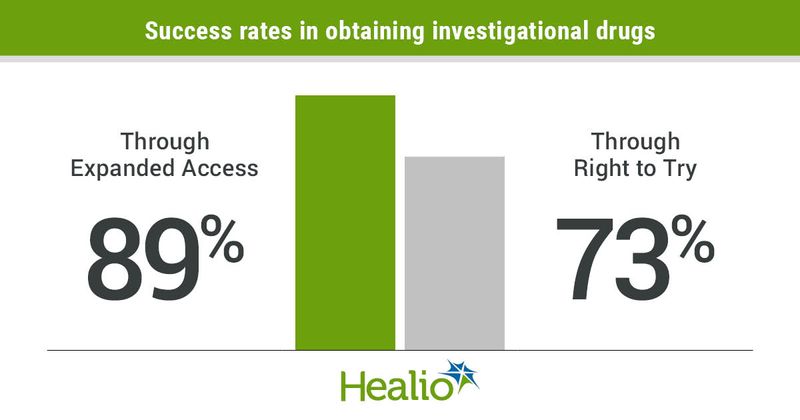Right to Try fails to show ‘edge’ vs. Expanded Access pathway among community oncologists
Use of the Right to Try pathway did not improve community oncologists’ ability to obtain investigational drugs compared with the FDA’s Expanded Access pathway, according to study results in JCO Oncology Practice.
“In our sample, taking the FDA out of the equation did not improve the odds of the patient receiving the drug,” study author Marjorie E. Zettler, PhD, MPH, director of clinical science at Regor Pharmaceuticals, told Healio. “I think this study shows that it doesn’t really give the edge that some of its proponents suggested it would.”

‘The key to access’
Right to Try — initially introduced as state legislation, with similar laws in 41 states — was signed into federal law by President Donald J. Trump in 2018.
The law allows terminally ill patients to appeal directly to manufacturers for access to unapproved drugs that have completed a phase 1 trial, are in active development, have not been approved by the FDA for any use, and are the subject of an investigational new drug application filed by the FDA.
Patients eligible for Right to Try must have a life-threatening illness, have exhausted all treatment options, and be unable to participate in a clinical trial of the requested drug.
The Expanded Access pathway — also known as Compassionate Use — is similar to Right to Try with one notable difference: After a manufacturer agrees to provide an investigational drug, the physician or manufacturer must petition the FDA to authorize use of the drug for the patient. An institutional review board must review the request and informed consent documentation prior to authorization.
Although proponents of Right to Try have maintained that sidestepping the FDA accelerates the authorization process, the agency approves most Expanded Access requests within days, requiring patient protection-related changes in only about 10% of cases.
According to Zettler, the biggest obstacle to obtaining investigational drugs through both Right to Try and Expanded Access is denial by the manufacturer.
“There are a number of reasons why a drug manufacturer might not want to provide investigational drugs outside of clinical trials,” Zettler said. “They might have limited supply of the drug and want to conserve it for the clinical trials, especially if it is expensive to make. They also might be concerned about jeopardizing their clinical development programs. Ultimately, the drug manufacturer holds the key to access.”
Physician awareness
For the study by Zettler and colleagues, 238 community oncologists-hematologists from across the United States responded to web-based surveys about their use and perceptions of Expanded Access and Right to Try pathways to secure investigational drugs for their patients.
When asked to isolate the main difference between Expanded Access and Right to Try, 65 respondents (27%) correctly indicated that Right to Try bypasses the FDA. When asked to identify the percentage of Expanded Access applications that FDA has approved, only seven respondents (3%) identified the correct option (more than 95%). Lastly, when asked how many patients had acquired investigational drugs through Right to Try as of June 2019, 26 respondents (11%) chose the correct option (two).
Utilization, success rates
In terms of utilization of the two programs, 46% of respondents indicated they had tried to gain access to an investigational drug for a patient through the Expanded Access program, whereas 14% indicated they attempted to gain access through Right To Try.
Of those who attempted to use Expanded Access, 89% reported success acquiring the drug, compared with 73% of those who attempted to use Right to Try.
“Overall, we found that the level of awareness of Expanded Access was very high among oncologists,” Zettler said. “[Although] only half of our sample had experience with the program, they were very successful in procuring investigational drugs for their patients. Awareness of Right to Try was lower, with only about one in seven oncologists we surveyed having experience with the program.”
Almost all respondents underestimated the rate of FDA approval of individual Expanded Access requests, and many overestimated the number of patients who received a drug through Right to Try.
The manufacturer denied the drug in 15% of Right to Try cases and 5% of Expanded Access cases. Approximately 3% of respondents reported denials by the FDA.
Zettler said she would like to see future studies evaluate success rates with Right to Try and Expanded Access in other rare diseases, such as ALS and Huntington’s Disease.
“Patients with cancer seem to have greater success in obtaining unapproved drugs than patients with other rare diseases,” she said. “There hasn’t been another study like ours surveying physicians who treat other rare diseases about their experience with Expanded Access or Right to Try. I would like to see those studies.”
For more information:
Marjorie E. Zettler, PhD, MPH, can be reached at marjoriezettler@gmail.com.

